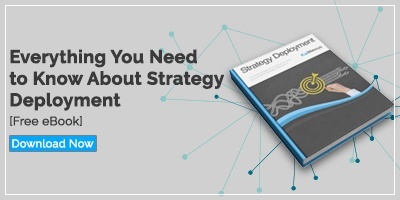 Maneuvering an organization toward its long-term strategic goals while managing day-to-day improvements and curtailing business processes demands systemic planning and an organization that is fully aligned. That’s the concept that drives Hoshin planning.
Maneuvering an organization toward its long-term strategic goals while managing day-to-day improvements and curtailing business processes demands systemic planning and an organization that is fully aligned. That’s the concept that drives Hoshin planning.
This post is designed to help you understand the fundamentals of Hoshin and the language that surrounds it. We’ll define some unfamiliar terms and concepts that can be confusing when new.
Lots more in-depth content has been written about Hoshin by us and others, but this is an excellent place to start.
What is Hoshin Planning?
Hoshin planning is a shorter version of the Japanese term “Hoshin Kanri,” which translates to English as “Strategy Deployment” or “Policy Deployment.” It can also be translated as “management compass” or “direction setting.” No matter what you call it, Hoshin planning is a management technique that first became popular in Japan in the 1950s. It is based on the thinking of Dr. Yoji Akao, a well respected Japanese professor.
The ultimate goal of Hoshin planning is to have every single person in the organization pointed in, and actively moving toward, the same direction, which is designated “True North.” That’s what sets Hoshin planning apart from management by objective and other planning approaches that are limited to setting KPIs at the executive level. While KPIs are essential, they are not sufficient for directing the activities of employees on a daily basis. For that, the front line staff needs to be very connected to how their small, incremental improvements can propel the organization toward the big-picture objectives.
The 5 Steps
While each organization may deploy them somewhat differently, there are five fundamental steps in the Hoshin planning process. They are:
1 – Define True North
Your organization may already have defined its mission, vision, and values. If so, the Hoshin planning kick-off is an excellent time to review them and ensure that they are still aligned with the desired future state of the company. If not, you’ll need to start by formally documenting and getting buy-in for each element. Once they are set and clearly understood, you can move to the development of True North categories for your three to five-year Hoshin plan. This isn’t a list of every change you’d like to see the organization make; rather it is a set of three to five truly strategic objectives.
2 – Develop Breakthrough and Annual Objectives
The Hoshin planning approach recognizes that you need to achieve short-term objectives and focus on long-term goals at the same time. Therefore, the aims of today and the long-run need to be closely aligned. During the Hoshin process, some goals represent a significant and revolutionary change for the organization, while others concern more subtle, incremental improvements. The breakthrough objectives usually impact profitability, growth, serious business challenges, new products, or new markets. Incremental annual goals support these categories.
3 – Cascade Goals Throughout the Organization
After True North is defined and the strategic objectives have been set, it is necessary to create organizational alignment by taking each high-level goal and breaking it down to what each department, team, and person will need to do to achieve it. These “local” goals should fit neatly into the True North categories.
4 – Define Projects and Tactics
This is another phase that sets Hoshin planning apart from other, more conceptual strategy development methods. At this point, the goals are milled into measurable projects at every level. Any project that is defined must align to the strategy and represent a step toward a breakthrough objective.
KPIs are defined for each project so that managers can track progress. Standardized KPI reporting is an essential element in true organizational alignment.
5 – Monthly and Annual Reviews
Your Hoshin plan is not something that should be developed in January and stuck in a file for the rest of the year. It needs constant attention to come to life and drive the engagement that will get your organization to True North.
Annual reviews help leaders to assess the likelihood that the breakthrough goals will be achieved in the expected timeframe. When needed, adjustments can be made, or additional resources deployed to get the objective back on track.
Monthly reviews are a useful tool for maintaining engagement in the execution of the plan. After all, it’s hard to keep focused on what needs to happen in the next year, but manageable to be attentive to what is expected in the next 30 days.
We’re not going to lie. Strategy deployment isn’t easy. If it were, more companies would achieve the success they desire, and leadership would be a piece of cake. Because it isn’t, the Hoshin planning process is an approach that can keep everyone rowing in the same direction as quickly and efficiently as possible.
For further reading we recommend:
Hoshin Kanri for the Lean Enterprise: Developing Competitive Capabilities and Managing by Thomas L. Jackson
Hoshin Kanri: Policy Deployment for Successful TQM by Yoji Akao
Getting the Right Things Done: A Leader's Guide to Planning and Execution by Pascal Dennis and Jim Womack


![[WEBINAR] Strategy Deployment Software Demo](https://no-cache.hubspot.com/cta/default/326641/67b72769-975a-48b1-b5d8-4ba0fe1f3b76.png)


Add a Comment